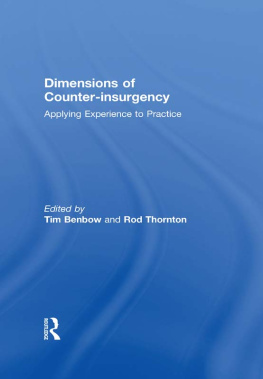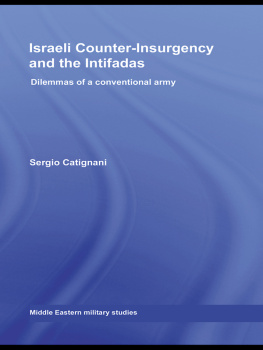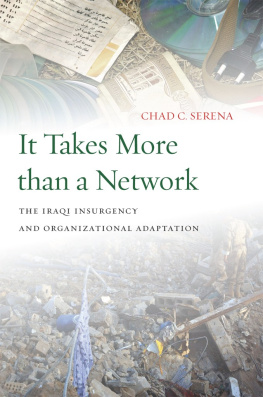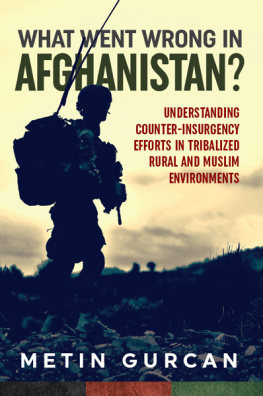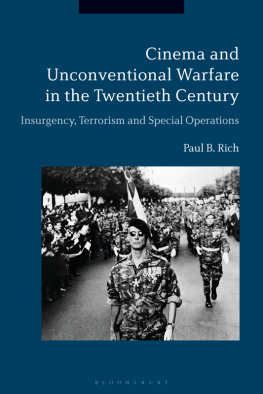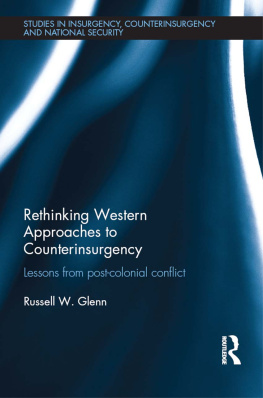Dimensions of Counter-insurgency
The once-neglected study of counter-insurgency operations has recently emerged as an area of central concern for Western governments and their military organizations. While counter-insurgency represents a hugely challenging form of contemporary warfare, there exists a considerable body of experience that offers assistance in the form of examples of both good and bad practice.
The main aim of this book is to present these examples and the lessons that can be drawn from them. Such lessons can be of considerable benefit to today's policy-makers and military practitioners. The book also considers how these lessons can actually fit into the contemporary framework as defined by military, political and institutional logic that shapes and bounds today's counter-insurgency warfare. Dimensions of Counter-insurgency explores a number of key themes including: the experience of counter-insurgency in the Middle East; the contribution of maritime and air forces; the challenges posed in adapting Western armed forces to their new tasks; and the responses made in light of the perceived need for international action against insurgencies by multilateral institutions such as NATO and the European Union. This book features a broad range of contributions from academics and military thinkers on both sides of the Atlantic.
This book was previously published as a special issue of Contemporary Security Policy.
Tim Benbow is a lecturer in the Defence Studies Department of King's College London at the Joint Services Command and Staff College. He is author of The Magic Bullet? Understanding the Revolution in Military Affairs, and of Maritime Power in the 199091 Gulf War and the Conflict in the Former Yugoslavia in Andrew Dorman, et al (eds.) The Changing Face of Maritime Power.
Rod Thornton is a lecturer in the School of Politics and International Relations at the University of Nottingham. He is a guest lecturer on Terrorism/Counter-insurgency at the NATO Defence School in Rome, and at the Joint Services Command and Staff College. He is author of Asymmetric Warfare: Threat and Response in the 21st Century.
Dimensions of Counter-insurgency
Applying Experience to Practice
Edited by
TIM BENBOW AND ROD THORNTON
First published 2008 by Routledge
2 Park Square, Milton Park, Abingdon, Oxon, OX14 4RN
Simultaneously published in the USA and Canada
by Routledge
711 Third Avenue, New York, NY 10017
Routledge is an imprint of the Taylor & Francis Group, an informa business
2008 Routledge
Typeset in Times-Roman by Techset Composition, Salisbury, UK
All rights reserved. No part of this book may be reprinted or reproduced or utilised in any form or by any electronic, mechanical, or other means, now known or hereafter invented, including photocopying and recording, or in any information storage or retrieval system, without permission in writing from the publishers.
British Library Cataloguing in Publication Data
A catalogue record for this book is available from the British Library
ISBN 13: 978-0-415-45037-9 (hbk)
ISBN 10: 0-415-45037-3 (hbk)
CONTENTS
| Tim Benbow |
| COUNTER-INSURGENCY IN THE MIDDLE EAST |
| Rod Thornton |
Simon Anglim |
Kate Utting |
| MARITIME AND AIR POWER |
Martin N. Murphy |
| Tim Benbow |
| David Jordan |
Harry Kemsley |
| MILITARY REFORM |
| James S. Corum |
Terry Terriff |
| THE MULTILATERAL RESPONSE |
| Sean Kay and Sahar Khan |
Tim Bird |
Simon Murden |
| Rod Thornton |
Historians of insurgency never tire of reminding their readers that there is little totally new in today's threats from non-state actors. In terms of technique and specific dangers, they are undoubtedly correct. But in terms of significance, it is a very different world. While the ideas of insurgency may be ancient, its salience is unprecedented. Previously, guerrilla and terrorist methods were something seen mostly at the periphery of international conflict. But in a world without periphery, they have greater global importance than ever before.
In a new report, Andrew Mack notes that never in recent history has there been less warfare.1 State-to-state war, which dominated strategic thinking throughout the Westphalian era, is increasingly exceptional. Where war remains, it is almost exclusively irregular and asymmetric. Insurgencies used to be wars of choice, something that major powers confronted almost exclusively when they went far astray. Now they are something they cannot avoid. Postmodern conflict is insurgent warfare. And as the fourth-generation warfare theorists rightly note, it has become more salient because it often works, gaining effectiveness through careful development by its practitioners.2
One result is an inversion of military priorities. As advocates of military transformation have learned to their dismay, what used to be primary is now secondary, and visa-versa. So long as insurgency could be dismissed as military pimple, major armed forces could resist efforts to master its principles. Anything more would acknowledge doubt over Clausewitzian warfare, their preferred expertise. As a result, almost every confrontation with counterinsurgency has been treated as a new experience. Experience was there, culminating repeatedly in classics like Callwell's Small Wars, Gwynn's Imperial Policing, and the US Marine Corps' Small Wars Manual.3 But Outside of literary milestones, accumulation of organizational learning has been rare. The inability or unwillingness of military institutions to adapt is a bureaucratic wonder.
That may be changing. Hopefully, the brutal message of Afghanistan and Iraq is too much for even the most backward-looking to dismiss. Where previous classics were exceptional examples, today there is a new sense of momentum. Rising awareness of fourth-generation warfare has encouraged an unprecedented coherence about insurgent challenges and responses. The publication of a new American field manual on counter-insurgency in late 2006 is a major institutional milestone.4
The editors of this special issue, Dr Tim Benbow and Dr Rod Thornton, both of King's College, London and Britain's Joint Services Command and Staff College, have taken the field even further. Applying both historical experience and current policy analysis, they show that the field of counter-insurgency is emerging from a past dominated by isolated classics and unrelated events. Instead, it is becoming genuinely cumulative, building systematically towards a new appreciation of the problems and possibilities for counter-insurgency in the 21st century. Although it remains early in the process, we may be witnessing the birth of a genuinely scientific approach to counter-insurgency.
In addition to the guest editors, we would like to thank the anonymous reviewers; their advice contributed directly to the strength of this volume of CSP. But above all, it is the 13 authors who have shown the way forward. Their efforts leave no doubt that counter-insurgency studies are ready to join security studies as a major sub-field.

